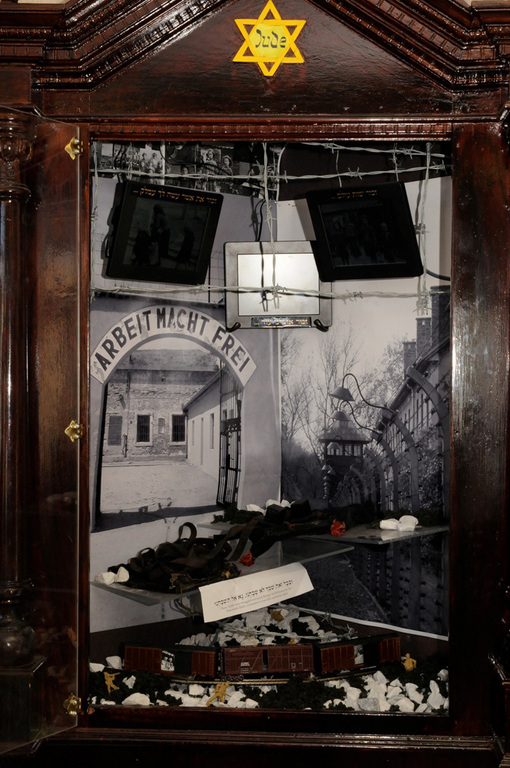Seeing themselves, remembering survivors
By Malka Eisenberg
Issue of April 16, 2010/ 2 Iyur 5770 Inside the main entrance of Yeshiva of South Shore stands a dark wood corner cabinet; on top of the cabinet is a yellow star with the word Jude. The glass display case houses three continuously changing video screens suspended over two concentration camp photos and a worn pair of small tefillin.The memorial is part of a yeshiva-wide program called Project Zachor. The program’s intent is to not only educate the students regarding the Holocaust but to have them connect with their history on a personal level by recalling, through names and photographs, relatives who survived or perished in the Holocaust.
“We will get every child’s picture and how he’s related to a survivor or someone who passed away in the Holocaust,” explained Rabbi Mordechai Kamenetzky, dean and rosh yeshiva of Yeshiva of South Shore. The goal, he said, is to “connect the generations.”
The diorama will have varying exhibits of artifacts from the war and screens showing photographs of people and scenes before, during and after the war.
Each screen has its own quote and reserve of photographs. The first, “zechor yimot olam” — remembering the past, has pictures of Europe before the Holocaust. The second, “zechor et asher asa lcha” — remember what was done to you, has pictures of the Holocaust. The third, “zechor ezkarenu od” — I will continue to remember, has pictures of the students, implying the promise and hope for the future.
The program began on Yom Hashoah and will continue through the year and the next few years. Students fill out a form with their name, grade, relationship to a Holocaust survivor, the name of the survivor, and where the survivor lived. Students also submit a picture of themselves and pictures of relatives who survived or died in the Holocaust. Rabbi Kamenetzky said that most students, except for some students with Sephardic roots, have some connection through a relative.
While the yeshiva has a program about the Holocaust on Yom Hashoah, Rabbi Kamenetzky stressed that it wasn’t enough. "I don’t believe that the Shoah should be remembered just one day a year, but should be inculcated all year in limudei kodesh and limudei chol,” he said.
Rabbi Kamenetzky recounted a visit by Rabbi Isaac Herzog, the Chief Rabbi of Ireland and eventually the Chief Rabbi of Israel, to a yeshiva in Chicago in 1948; he had come from a monastery in France to find Jewish children hidden there during the Holocaust. Rabbi Herzog was repeatedly turned away from the monastery and told that the “Schwartzes and the Schindlers” were all Germans.
“We may have lost those children,” Rabbi Herzog related to the yeshiva students in Chicago, “ but we have you.”
“We have to carry on,” emphasized Rabbi Kamenetzky. The children “have to learn about the past and carry on the traditions.”
Ezra Sturm, 13, who is in the seventh grade in the yeshiva, said he understood the message.
“It’s important to know that people went through the Shoah and what they went through,” he said. All four of Sturm’s grandparents are survivors.
Nadav Menashy, 13, said that he was proud of his grandfather, survivor Rabbi Israel Post, of blessed memory, and was thankful to Hashem to have known him.
“They are the last generation to see survivors,” said Rabbi Kamenetzky. “They have to know that they are part of the chain.”

 51.0°,
Light Rain
51.0°,
Light Rain 




